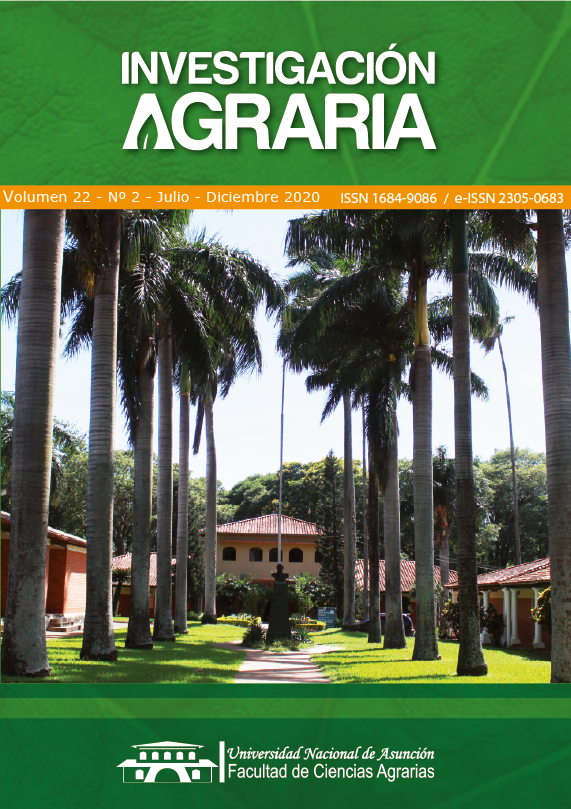Effect of different sources and concentrations cytokinin in vitro multiplication of Luehea divaricata Mart. & Zucc.
DOI:
https://doi.org/10.18004/investig.agrar.2020.diciembre.2202667Keywords:
growth regulators, 6-benzylaminopurine, TDZAbstract
Seminal Luehea divaricata seedling production has been limited by the low availability of seeds with appropriate physiological and health atributes. Studies regarding the vegetative propagation of Luehea divaricata Mart. & Zucc showed that the species has a potential multiplication through methods alternative to seeds. The aim of this study was to evaluate the response of cultures initiated from Luehea divaricata Mart. & Zucc epicotyl, to stimuli from different sources and concentrations of cytokinin in vitro multiplication. Epicotyls containing one or two axillary buds were used, in which treatments were 0, 5, 10 or 15μM of cytokine: 2-isopentenyladenine (2iP), 6-benzylaminopurine (BA), Kinetin (KIN) and Thidiazuron (TDZ) sources added to the nutrient broth medium, distributed in a completely randomized design. At 45 days of culture, there was an interaction between the sources and the cytokinin concentrations used, affecting the percentage of in vitro establishment (86.2%), number of buds (6.82), number of shoots (2.48), number of leaves (8.5), while the percentage of callus formation was influenced by the concentrations of cytokinins (48%). It was concluded that the in vitro multiplication of cultures initiated from epicotyls of Luehea divaricata Mart. & Zucc, the use of cytokinins 6-benzylaminopurine (BAP), 2-isopentenyladenine (2iP), Kinetin (KIN) and Thidiazuron (TDZ) is dispensable. In the absence of cytokinins nutrient broth medium, better responses were observed in relation to in vitro survival and establishment, bud number and number of leaves formed and BAP, 2ip, KIN and TDZ at concentrations between 5 and 15μM, promote callus formation.Downloads
Metrics
References
Barrueto-Cid, L. P. (2005). Hormônios vegetais em plantas superiores. Brasília, DF: Embrapa Recursos Genéticos e Biotecnología, 188 p.
Barrueto-Cid, L. P. (2010). Cultivo in vitro de plantas. Brasília, DF: Embrapa Informação Tecnológica: Embrapa Recursos Genéticos e Biotecnologia, 303 p.
Chami, L.B., Araújo, M. M. , Longhi, S. J. , Kielse, P. y Lúcio, A.D. (2011). Mecanismos de regeneração natural em diferentes ambientes de remanescente de Floresta Ombrófila Mista, São Francisco de Paula, RS. Ciéncia Rural, 41(2), 251-259.
Dutra, L. F., Wendling, I. & Brondani, G. E. (2009). A Micropropagação de eucalipto. Pesquisa Florestal Brasileira, 58, 49-59.
Erig, A. C., De Rossi, A. e Fortes, G. R. L. (2002). 6-Benzilaminopurina e ácido indolbutírico na multiplicação in vitro da amoreira-preta (Rubus idaeus L.), cv. Tupy. Ciência Rural , 32(5), 765-770.
Ferreira, D. F. (2011). Sisvar: a computer statistical analysis system. Ciéncia e Agrotecnologia, 35(6), 1039-1042.
Flôres, A.V., Reiniger, L.R.S., Curti, A.R., Cunha, A. C. M. C. M. da, Golle, D. P. e Bassan, J.S. (2011). Estabelecimento e multiplicação in vitro de Luehea divaricata Mart. & Zucc. Ciéncia Florestal, 21(1), 175-182.
Grattapaglia, D. e Machado, M.A.(1998). Micropropagação. In: Torres, A.C., Caldas, L.S., Buso, J.A. Cultura de tecidos e transformação genética de plantas. Brasília: EMBRAPA-SPI/EMBRAPA-CNPH, v. 1, p. 183-260.
Murashige, T. & Skoog, F. (1962). A revised medium for rapid growth and bio-assays with tobacco tissue cultures. Physiologia Plantarum, 1, 437-496.
Published
How to Cite
Issue
Section
License

This work is licensed under a Creative Commons Attribution 4.0 International License.
All content in this journal is under Creative Commons Attribution License.









 All content in this journal is under
All content in this journal is under 